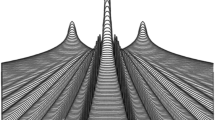Abstract
Two linear In this letter, we prove the following conclusions by introducing a function F n (t): (1) If a quantum system S with a time-dependent non-degenerate Hamiltonian H(t) is initially in the n-th eigenstate of H(0), then the state of the system at time t will remain in the n-th eigenstate of H(t) up to a multiplicative phase factor if and only if the values F n (t) for all t are always on the circle centered at 1 with radius 1; (2) If a quantum system S with a time-dependent Hamiltonian H(t) is initially in the n-th eigenstate of H(0), then the state of the system at time t will remain ɛ-uniformly approximately in the n-th eigenstate of H(t) up to a multiplicative phase factor if and only if the values F n (t) for all t are always outside of the circle centered at 1 with radius 1−ɛ. Moreover, some quantitative sufficient conditions for the state of the system at time t to remain ɛ-uniformly approximately in the n-th eigenstate of H(t) up to a multiplicative phase factor are established. Lastly, our results are illustrated by a spin-half particle in a rotating magnetic field.
Similar content being viewed by others
References
Born M, Fock V. Beweis des adiabatensatzes. Z Phys, 1928, 51: 165–180
Schwinger J. On nonadiabatic processes in inhomogeneous Fields. Phys Rev, 1937, 51: 648–651
Schiff L I. Quantum Mechanics. New York: McGraw-Hill Book Co. Inc., 1949
Kato T. On the adiabatic theorem of quantum mechanics. J Phys Soc Jpn, 1950, 5: 435–439
Messiah A. Quantum Mechanics. Amsterdam: North-Holland, Pub. Co., 1962
Bohm D. Quantum Theory. New York: Prentic-Hall Inc., 1951
Landau L D. Theory of energy transfer II. Zeitschrift, 1932, 2: 46–51
Zener C. Non-adiabatic crossing of energy levels. Proc R Soc A, 1932, 137: 696–702
Gell-Mann M, Low F. Bound states in quantum field theory. Phys Rev, 1951, 84: 350–354
Berry M V. Quantum phase factors accompanying adiabatic changes. Proc R Soc A, 1984, 392: 45–57
Avron J E, Seiler R, Yaffe L G. Adiabatic theorems and applications to the quantum Hall effect. Commun Math Phys, 1987, 110: 33–49
Farhi E, Goldstone J, Gutmann S, et al. A quantum adiabatic evolution algorithm applied to random instances of an NP-complete problem. Science, 2001, 292: 472–475
Sarandy M S, Lidar D A. Adiabatic quantum computation in open systems. Phys Rev Lett, 2005, 95: 250503
Thunstrom P, Aberg J, Sjoqvist E. Adiabatic approximation for weakly open systems. Phys Rev A, 2005, 72: 022328
Tong D M, Singh K, Kwek L C, et al. Sufficiency criterion for the validity of the adiabatic approximation. Phys Rev Lett, 2007, 98: 150402
Tong D M. Quantitative condition is necessary in guaranteeing the validity of the adiabatic approximation. Phys Rev Lett, 2010, 104: 120401
Tong D M, Singh K, Kwek L C, et al. Quantitative conditions do not guarantee the validity of the adiabatic approximation. Phys Rev Lett, 2005, 95: 110407
Ambainis A, Regev O. An elementary proof of the quantum adiabatic theorem. arXiv:quant-ph/0411152v2
Avron J E, Fraas M, Graf G M, et al. Adiabatic theorems for generators of contracting evolutions. arXiv:1106.4661v2
Chen B, Shen Q H, Fan W, et al. Long-range adiabatic quantum state transfer through a linear array of quantum dots. Sci China-Phys Mech Astron, 2012, 55(9): 1635–1640
Sun J, Lu S F, Liu F. Speedup in adiabatic evolution based quantum algorithms. Sci China-Phys Mech Astron, 2012, 55(9): 1630–1634
Xu G F, Kwek L C, Tong D M. Effects of noisy quantum channels on one-qubit rotation gate. Sci China-Phys Mech Astron, 2012, 55(5): 808–814
Cong S, Liu J X. Trajectory tracking control of quantum systems. Chin Sci Bull, 2012, 57(18): 2252–2258
Liu W F, Zhang C B, Chen Z H. Multi-step evolution and measurement control of finite-dimensional quantum systems. Chin Sci Bull, 2012, 57(18): 2233–2241
Author information
Authors and Affiliations
Corresponding author
Rights and permissions
About this article
Cite this article
Cao, H., Guo, Z., Chen, Z. et al. Quantitative sufficient conditions for adiabatic approximation. Sci. China Phys. Mech. Astron. 56, 1401–1407 (2013). https://doi.org/10.1007/s11433-013-5127-0
Received:
Accepted:
Published:
Issue Date:
DOI: https://doi.org/10.1007/s11433-013-5127-0




